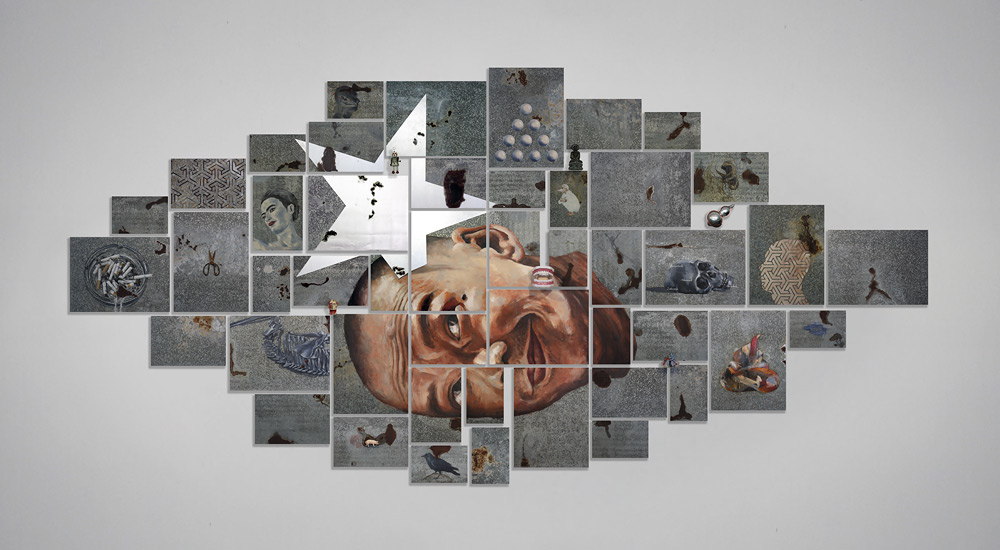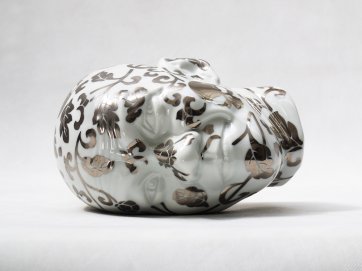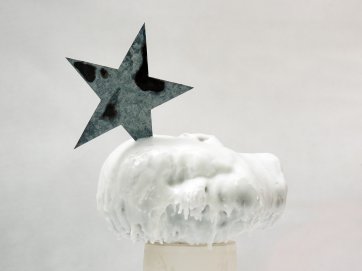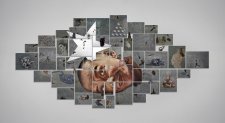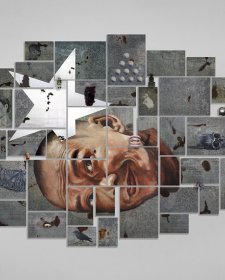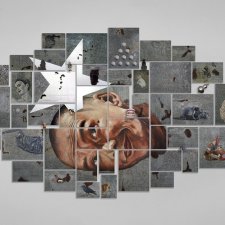Eventually Suwage decided to abandon his career in graphic design to concentrate on his art practice, which has from its earliest stages included a strong focus on self portraiture. By the mid-1990s he was becoming well-known in Indonesia and internationally for his provocative drawings, installations, paintings and assemblages, which incorporate popular culture and religious imagery, and examinations of the relationship between human and animal. Suwage lives and works in Yogyakarta.
Beyond the Self, Beyond the Portrait
The presence of self portraiture as a particular genre in the development of Indonesian modern art requires special attention, not least because the self portrait signifies the awareness of the respective artists as individuals, as well as about their positions in the society.
In her book Art in Indonesia: Continuities and change, Claire Holt noted this phenomenon: ‘The unprecedented emergence of the individual in the works of painters during and after the war is one of the significant phenomena to be noted. In Java, the assertion “I am”, followed by the question “Who am I” is reflected in self portraits of different styles and moods’.1
Holt based her observations on the fact that a number of Indonesian artists began presenting self portraits as the main subject of their paintings (for example Affandi, Soedibio and Tarmizi). In the nearly four decades after Claire Holt’s research took place, there was no artist in Indonesia who was so keen and consistent in presenting self portraits as Affandi had been. This remained true until the mid-nineties, when Agus Suwage started to present self portraits in his works. To this day, Agus Suwage keeps on creating self portraits in a variety of forms, using a range of techniques.
This essay is an effort to briefly trace how Agus Suwage began presenting works with self portraits as the main theme, and how he subsequently develops the theme. In some of the works, his self portraits are not yet present as an independent subject, serving as the centre, but instead exist alongside other elements. In the same vein as Affandi, Suwage once said that in terms of painting, self portraits are ‘the easiest’ because the model is ready anytime the artist requires him to be.
The technical difference between the two artists lies in the fact that Affandi painted himself by observing his reflection in the mirror, while Agus Suwage takes advantage of the technology of cameras and photography. This difference has implications in the way each artist represents “the self”, as well as the way they position themselves within the narrative structures of their works. This last issue might serve as the basis to see how the artists position themselves in relationship with other people, the community, the society and the world.
By simplifying a number of issues, Affandi’s self portraits can be described as revealing a myriad of personal emotions related to his life experiences. This is true for his self portraits in which he appears alone, those with his children, as well as the symbolic works where he paints his face next to the sun.
With Suwage, the self portraits he presents are a combination between the reflection of the ‘self’ and the contrivance about the “self”, as he relies on the camera to record a variety of his poses and facial expressions, before transforming these visual records into drawings or paintings. Agus Suwage uses this procedure because in reality the narratives that he develops in his works – albeit invariably having a personal aspect – are in fact related to his stance and views about the different social issues around him. He once stated that ‘in order to be critical toward others, I opt to first be critical toward myself’.
In other words, Agus Suwage never entirely treats his self portraits as the representation of his whole self. His figure and face in the works are not the self that is present, exists and serves as the centre (the conscious self, the Cartesian subject). Apparently, he accepts the fact that he is a subject and at the same time also an ‘object’ in relation to the various conditions external to his self. His self portraits serve as the recognition about the self that can be fragmented, the decentred self-subjectivity, and the identity of the self that can never be thoroughly stable when existing in the network of social relations.
Such awareness is obvious in his work Aku melihat, aku mendengar, aku merasa (I see, I hear, I feel) 1994–2001, one of the significant works that serve as a landmark for the development of his future self portraits. The work reveals Agus Suwage’s self portraits in a variety of poses that are actually in opposition to what the title suggests. What we see on canvas are poses of the artist closing his eyes, blocking his ears, screaming, huddling – closing himself off from ‘the world’.
St. Sunardi, in his review of the work, comments: ‘What does he hear with his ears blocked? What does he feel with his hysterical body? Mental images! Shadows! They are all imagined. Suwage doesn’t find anything but shadow. Like it or not, his self is nothing but shadows – at times he doesn’t want to see this truth, but at other times he even plays with them.’2
Suwage’s self portraits constitute the autoscopic self. The distance between the self and the shadow provides the artist with a playground of sorts. It is the space that enables him to take an adequate distance to observe himself while at the same time observing the world around him. This space makes it possible for him to be cynical, critical, questioning or even able to laugh about a variety of issues through his ‘self’, often by using ‘himself’ as the main target.
Such a stance is evident in the series Man of the year, which he has been developing since 2009 using a variety of media, starting from sculptures, painting on canvas, to watercolour on paper. Such a creative development is common for Agus Suwage. He works like a music composer: starting from a simple melodic theme, moving on to creating varieties of the theme, finally arriving at a complex composition.
The main visual element of these works reveals Agus Suwage’s head lying on the floor, pierced by a sharp object in the form of a star. The artist, however, does not seem to be in pain. Instead, he is ‘grinning’ blithely. As we consider the title, we can presume that the series comments on the development in the Indonesian art market that can rapidly propel an artist into celebrity status as the prices of his or her works skyrocket. The artist might take different routes: feeling tortured as he or she becomes the target of the market that treats the works merely as commodities, or enjoying the fame and ensuing prosperity. Or, the artist might also take a carefree attitude and accept the conditions. This time, Agus Suwage also presents his self portraits in the midst of a vortex of death-related signs, over fragmented zinc plates that look all dull and rusty. The grandness of the Man of the year is an irony amid the multitude signs of ruin and decay.
Enin Supriyanto
Director of Langgeng Art Foundation
Yogyakarta, Indonesia
1 Claire Holt, Art in Indonesia: Continuities and change, Ithaca: Cornell University Press, 1967, p. 257.
2 St. Sunardi, Perish: Agus Suwage’s imaginary realism, in Enin Supriyanto (ed.), Still crazy after all these years, Agus Suwage’s Archive: 1985–2009, Yogjakarta: Studio Biru, 2010, p. 41.
